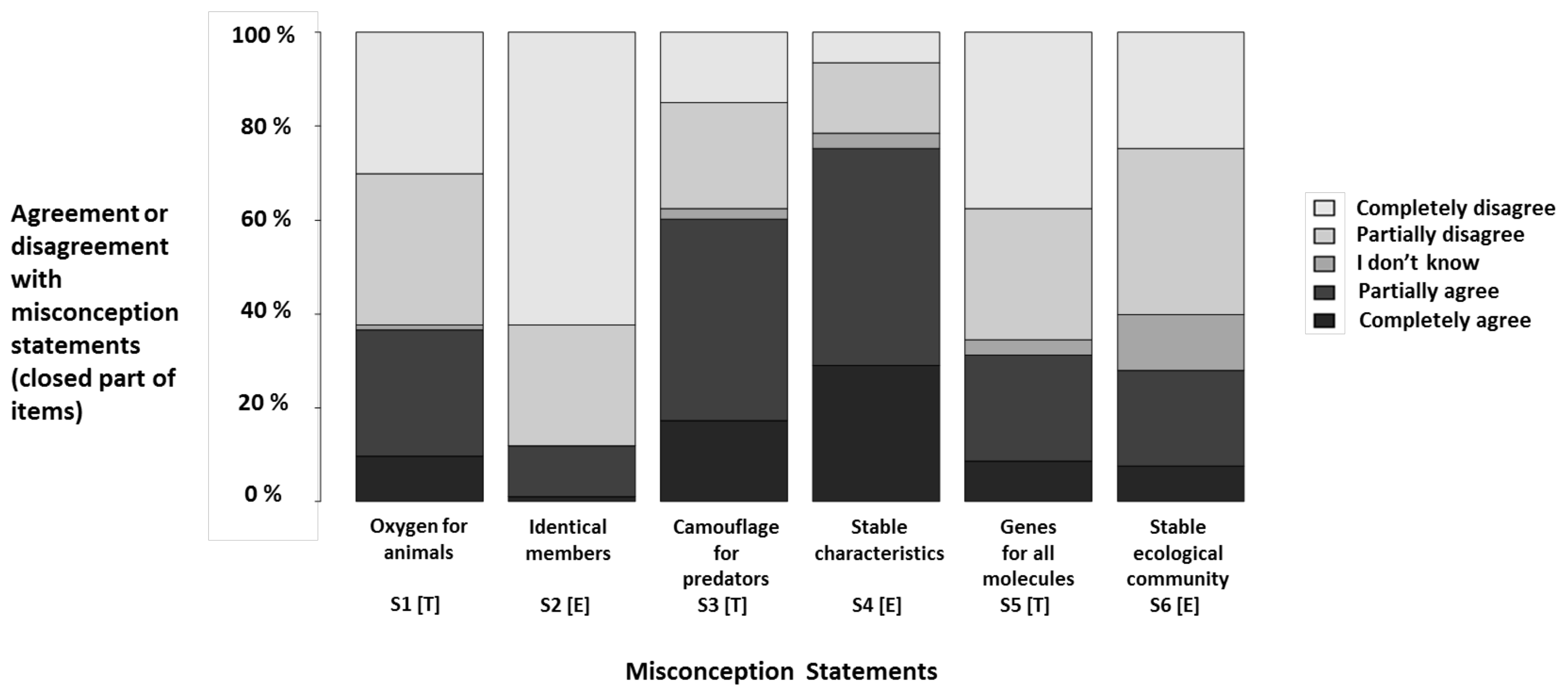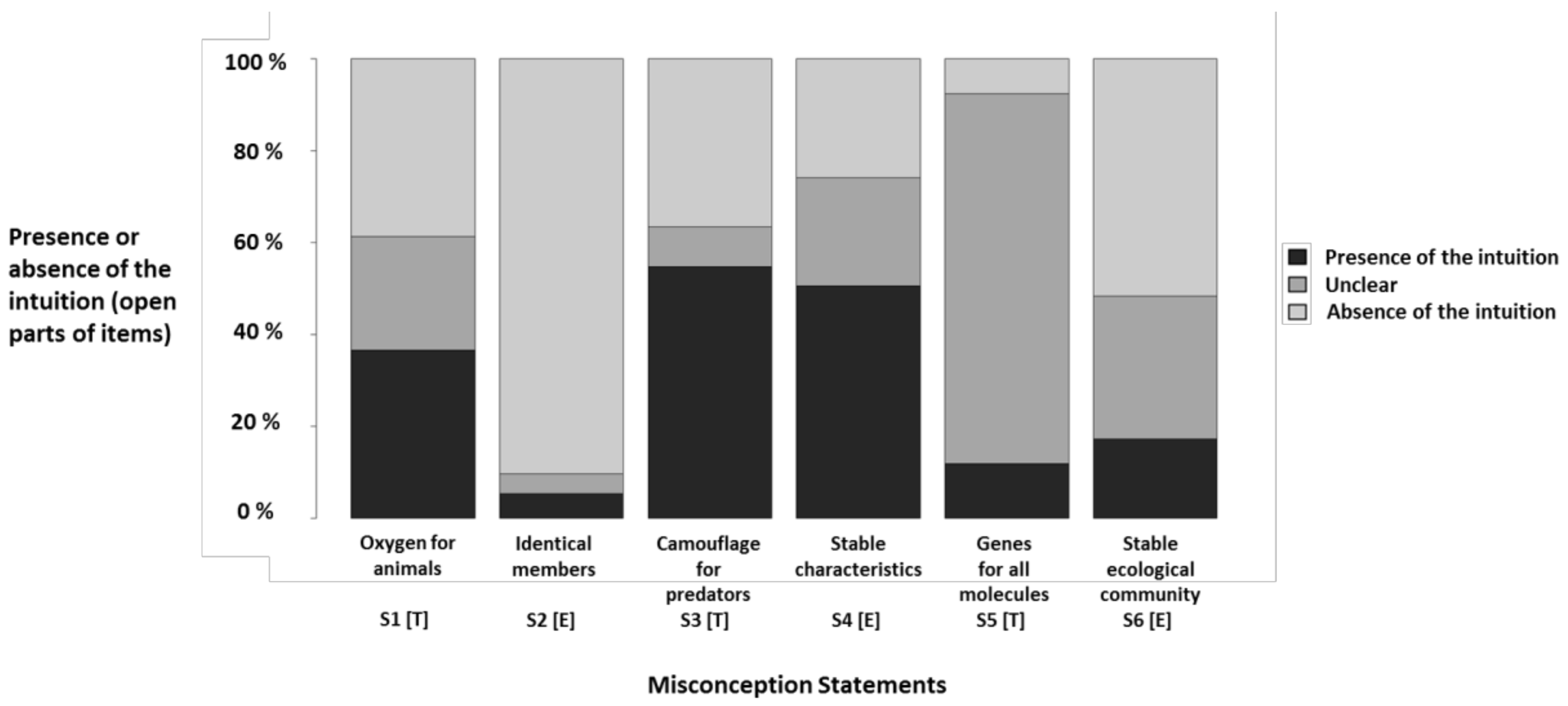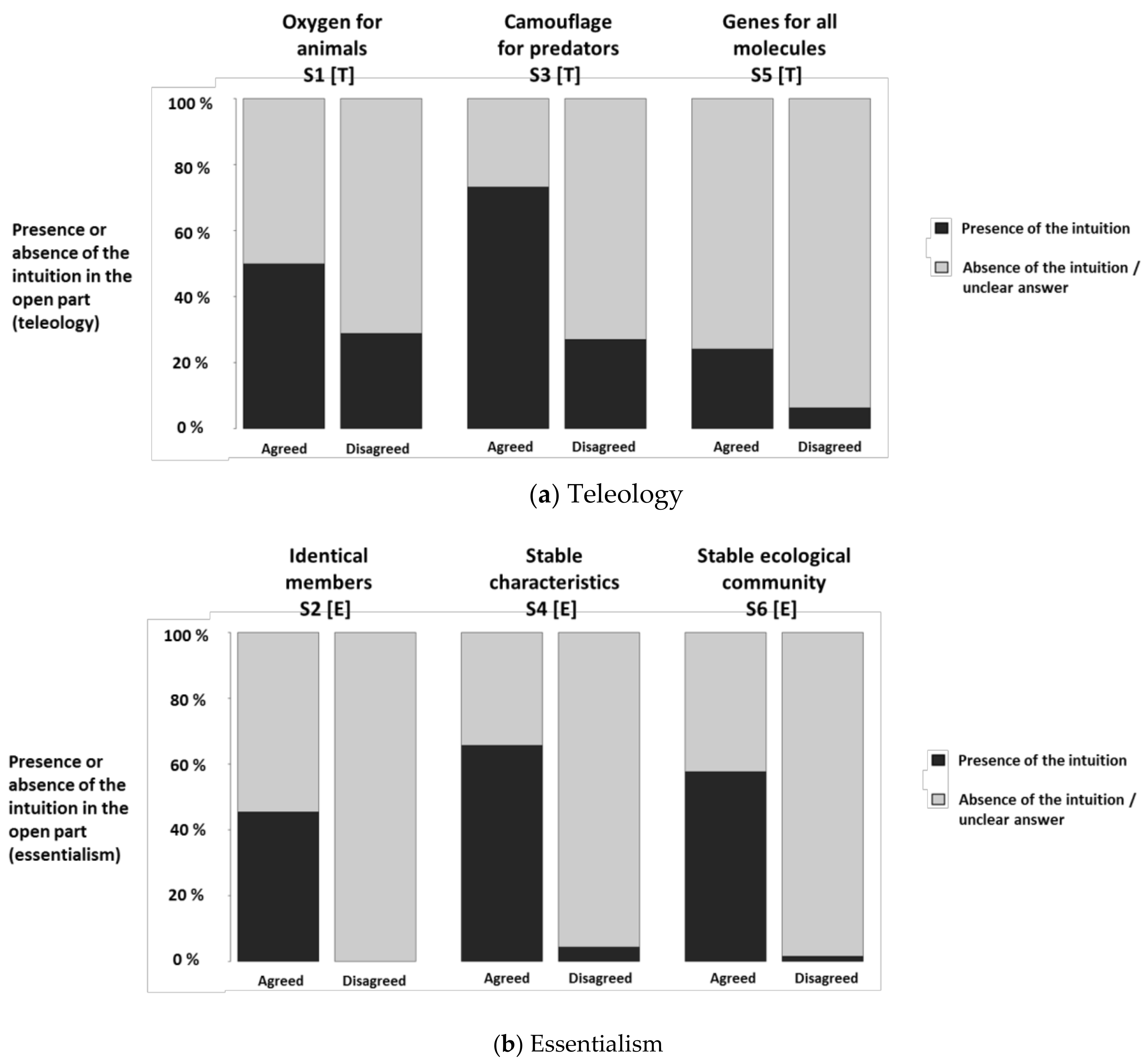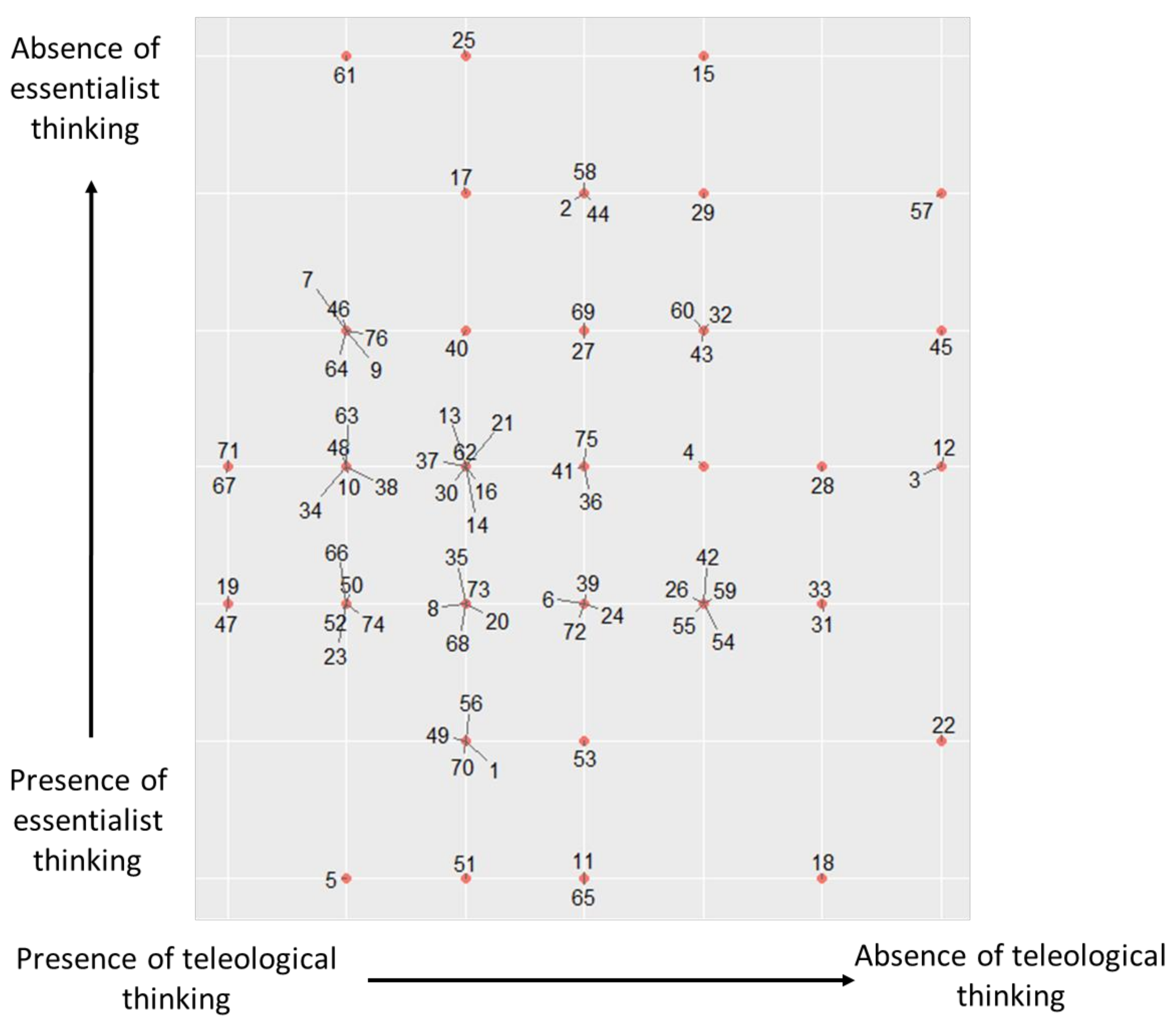Undergraduate Biology Students’ Teleological and Essentialist Misconceptions
Abstract
1. Introduction
2. Theoretical Background: Teleology and Essentialism
2.1. Teleological Thinking in Biology
- Genes turn on so that the cell can develop properly;
- Birds have wings so they can fly;
- Plants give off oxygen, because animals need oxygen to survive;
- Individual organisms adapt and change to fit their environments;
- Evolution is the striving toward higher forms of life on earth.
2.2. Essentialist Thinking in Biology
- Homeostasis keeps the body static and unchanging;
- Members of the same species are almost identical in their physical characteristics;
- If left alone, a wetland ecosystem will remain a wetland indefinitely;
- Because different cells in an organism have different physical characteristics, they must contain different DNA;
- Changing a single gene in an organism results in a new kind of organism.
2.3. Research Questions
- What level of agreement with teleological and essentialist misconception statements do 1st year undergraduate biology students exhibit?
- Are 1st year undergraduate biology students consistent in their responses within the various items? That is, are they consistent in their agreement or disagreement with each misconception statement and the respective justification?
- Are 1st year undergraduate biology students consistent in their responses between the various items of the same type? That is, are their responses either to the three teleological or to the three essentialist statements consistent with one another?
- Is there a correlation between 1st year undergraduate biology students’ teleological and essentialist conceptions as documented by their responses to the items of this study?
3. Methods
3.1. Misconception Statements
3.2. Participants
3.3. Research Instrument
- (1)
- A closed part that included one of the six misconception statements in Table 1, for each of which students were asked to express their degree of agreement or disagreement on a 5-level scale (“completely disagree”; “rather disagree”; “I do not know”; “rather agree”; “completely agree”);
- (2)
- An open part in which they were asked to justify their choice in the first part of each item. In this case, students had adequate space (a few lines) to describe their thinking.
3.4. Analysis
4. Results
4.1. Prevalence of Misconceptions among Students
4.1.1. Students’ Responses to the Closed Parts of Items
4.1.2. Students’ Responses to the Open Parts of Items
4.2. Students’ Consistency within Items
4.3. Students’ Consistency between Items
4.4. Overall Relation between Teleological and Essentialist Conceptions
5. Discussions
5.1. Comparison of Results to Those in the Coley & Tanner Study
5.2. Limitations of the Present Study
5.3. Conclusions from the Present Study and Implications for Undergraduate Biology Education
Author Contributions
Acknowledgments
Conflicts of Interest
Appendix A. The Items Used in the Study Reported in This Article (in French)
- ☐
- je suis en désaccord
- ☐
- je suis plutôt en désaccord
- ☐
- je suis plutôt d’accord
- ☐
- je suis complètement d’accord
- ☐
- je ne sais pas
- ☐
- je suis en désaccord
- ☐
- je suis plutôt en désaccord
- ☐
- je suis plutôt d’accord
- ☐
- je suis complètement d’accord
- ☐
- je ne sais pas
- ☐
- je suis en désaccord
- ☐
- je suis plutôt en désaccord
- ☐
- je suis plutôt d’accord
- ☐
- je suis complètement d’accord
- ☐
- je ne sais pas
- ☐
- je suis en désaccord
- ☐
- je suis plutôt en désaccord
- ☐
- je suis plutôt d’accord
- ☐
- je suis complètement d’accord
- ☐
- je ne sais pas
- ☐
- je suis en désaccord
- ☐
- je suis plutôt en désaccord
- ☐
- je suis plutôt d’accord
- ☐
- je suis complètement d’accord
- ☐
- je ne sais pas
- ☐
- je suis en désaccord
- ☐
- je suis plutôt en désaccord
- ☐
- je suis plutôt d’accord
- ☐
- je suis complètement d’accord
- ☐
- je ne sais pas
Appendix B. The Items Used in the Study Reported in This Article (in English)
- ☐
- I completely disagree
- ☐
- I mostly disagree
- ☐
- I mostly agree
- ☐
- I completely agree
- ☐
- I do not know
- ☐
- I completely disagree
- ☐
- I mostly disagree
- ☐
- I mostly agree
- ☐
- I completely agree
- ☐
- I do not know
- ☐
- I completely disagree
- ☐
- I mostly disagree
- ☐
- I mostly agree
- ☐
- I completely agree
- ☐
- I do not know
- ☐
- I completely disagree
- ☐
- I mostly disagree
- ☐
- I mostly agree
- ☐
- I completely agree
- ☐
- I do not know
- ☐
- I completely disagree
- ☐
- I mostly disagree
- ☐
- I mostly agree
- ☐
- I completely agree
- ☐
- I do not know
- ☐
- I completely disagree
- ☐
- I mostly disagree
- ☐
- I mostly agree
- ☐
- I completely agree
- ☐
- I do not know
References
- Vosniadou, S. Reframing the classical approach to conceptual change: Preconceptions, misconceptions and synthetic models. In Second International Handbook of Science Education; Fraser, B.J., Tobin, K., McRobbie, C.J., Eds.; Springer: Dordrecht, The Netherlands, 2012; pp. 119–130. ISBN 978-1-4020-9041-7. [Google Scholar]
- Leonard, M.J.; Kalinowski, S.T.; Andrews, T.C. Misconceptions yesterday, today, and tomorrow. CBE Life Sci. Educ. 2014, 13, 179–186. [Google Scholar] [CrossRef] [PubMed]
- Keil, F.C. Science starts early. Science 2011, 331, 1022–1023. [Google Scholar] [CrossRef] [PubMed]
- Solomon, G.E.; Johnson, S.C.; Zaitchik, D.; Carey, S. Like father, like son: Young children’s understanding of how and why offspring resemble their parents. Child. Dev. 1996, 67, 151–171. [Google Scholar] [CrossRef] [PubMed]
- Williams, J.M.; Smith, L.A. Concepts of kinship relations and inheritance in childhood and adolescence. Br. J. Dev. Psychol. 2010, 28, 523–546. [Google Scholar] [CrossRef] [PubMed]
- Williams, J.M. Children and adolescents’ understandings of family resemblance: A study of naïve inheritance concepts. Br. J. Dev. Psychol. 2012, 30, 225–252. [Google Scholar] [CrossRef] [PubMed]
- Banet, E.; Ayuso, E. Teaching genetics at secondary school: A strategy for teaching about the location of inheritance information. Sci. Educ. 2000, 84, 313–351. [Google Scholar] [CrossRef]
- Castéra, J.; Clément, P. Teachers’ conceptions about the genetic determinism of human behaviour: A survey in 23 countries. Sci. Educ. 2014, 23, 417–443. [Google Scholar] [CrossRef]
- Gericke, N.M.; Hagberg, M.; dos Santos, V.C.; Joaquim, L.M.; El-Hani, C.N. Conceptual variation or incoherence? Textbook discourse on genes in six countries. Sci. Educ. 2014, 23, 381. [Google Scholar] [CrossRef]
- Stern, F.; Kampourakis, K. Teaching for genetics literacy in the post-genomic era. Stud. Sci. Educ. 2017, 53, 193–225. [Google Scholar] [CrossRef]
- Andrews, T.M.; Price, R.M.; Mead, L.S.; McElhinny, T.L.; Thanukos, A.; Perez, K.E.; Herreid, C.F.; Terry, D.R.; Lemons, P.P. Biology Undergraduates’ Misconceptions about genetic drift. CBE Life Sci. Educ. 2012, 11, 248–259. [Google Scholar] [CrossRef] [PubMed]
- Anderson, D.L.; Fisher, K.M.; Norman, G.J. Development and evaluation of the conceptual inventory of natural selection. J. Res. Sci. Teach. 2002, 39, 952–978. [Google Scholar] [CrossRef]
- Wilson, C.D.; Anderson, C.W.; Heidemann, M.; Merrill, J.E.; Merritt, B.W.; Richmond, G.; Sibley, D.F.; Parker, J.M. Assessing students’ ability to trace matter in dynamic systems in Cell Biology. CBE Life Sci. Educ. 2006, 5, 323–331. [Google Scholar] [CrossRef] [PubMed]
- Canal, P. Photosynthesis and “inverse respiration” in plants: an inevitable misconception? Int. J. Sc. Educ. 1999, 21, 363–371. [Google Scholar] [CrossRef]
- Kelemen, D. Teleological minds: How natural intuitions about agency and purpose influence learning about evolution. In Evolution Challenges: Integrating Research and Practice in Teaching and Learning about Evolution; Rosengren, K.S., Brem, S., Evans, E.M., Sinatra, G., Eds.; Oxford University Press: New York, NY, USA, 2012; pp. 66–92. ISBN 978-0-19-994955-7. [Google Scholar]
- Gelman, S.A.; Rhodes, M. “Two-thousand years of stasis”: How psychological essentialism impedes evolutionary understanding. In Evolution Challenges: Integrating Research and Practice in Teaching and Learning about Evolution; Rosengren, K.S., Brem, S., Evans, E.M., Sinatra, G., Eds.; Oxford University Press: New York, NY, USA, 2012; ISBN 978-0-19-994955-7. [Google Scholar]
- Kampourakis, K. Understanding Evolution, 1st ed.; Cambridge University Press: New York, NY, USA, 2014; ISBN 978-1-107-61020-0. [Google Scholar]
- Coley, J.D.; Tanner, K.D. Relations between intuitive biological thinking and biological misconceptions in Biology majors and nonmajors. CBE Life Sci. Educ. 2015, 14. [Google Scholar] [CrossRef] [PubMed]
- Coley, J.D.; Tanner, K.D. Common origins of diverse misconceptions: Cognitive principles and the development of Biology thinking. CBE Life Sci. Educ. 2012, 11, 209–215. [Google Scholar] [CrossRef] [PubMed]
- Tamir, P.; Zohar, A. Anthropomorphism and teleology in reasoning about biological phenomena. Sci. Educ. 1991, 75, 57–67. [Google Scholar] [CrossRef]
- Lennox, J.G.; Kampourakis, K. Biological teleology: The need for history. In The Philosophy of Biology: A Companion for Educators; Kampourakis, K., Ed.; Springer: Dordrecht, The Netherlands, 2013; pp. 421–454. [Google Scholar]
- Kelemen, D. Why are rocks pointy? Children’s preference for teleological explanations of the natural world. Dev. Psychol. 1999, 35, 1440–1452. [Google Scholar] [CrossRef] [PubMed]
- Kelemen, D. Function, goals and intention: Children’s teleological reasoning about objects. Trends Cogn. Sci. 1999, 3, 461–468. [Google Scholar] [CrossRef]
- Keil, F.C. The birth and nurturance of concepts by domains: The origins of concepts of living things. In Mapping the Mind: Domain Specificity in Cognition and Culture; Hirschfeld, L.A., Gelman, S.A., Eds.; Cambridge University Press.: Cambridge, UK, 1994; pp. 234–254. [Google Scholar]
- Kampourakis, K.; Palaiokrassa, E.; Papadopoulou, M.; Pavlidi, V.; Argyropoulou, M. Children’s intuitive teleology: Shifting the focus of evolution education research. Evo. Educ. Outreach 2012, 5, 279–291. [Google Scholar] [CrossRef]
- Ware, E.A.; Gelman, S.A. You get what you need: An examination of purpose-based inheritance reasoning in undergraduates, preschoolers, and biological experts. Cogn. Science 2014, 38, 197–243. [Google Scholar] [CrossRef]
- Kelemen, D.; Rottman, J.; Seston, R. Professional physical scientists display tenacious teleological tendencies: Purpose-based reasoning as a cognitive default. J Exp. Psychol. Gen. 2013, 142, 1074–1083. [Google Scholar] [CrossRef] [PubMed]
- Casler, K.; Kelemen, D. Developmental continuity in teleo-functional explanation: Reasoning about nature among romanian romani adults. J. Cogn. Dev. 2008, 9, 340–362. [Google Scholar] [CrossRef]
- Rottman, J.; Zhu, L.; Wang, W.; Schillaci, R.S.; Clark, K.J.; Kelemen, D. Cultural influences on the teleological stance: Evidence from China. Relig. Brain Beha. 2017, 7, 17–26. [Google Scholar] [CrossRef]
- Wilkins, J. Essentialism in Biology. In The Philosophy of Biology: A Companion for Educators; Kampourakis, K., Ed.; Springer: Dordrecht, The Netherlands, 2013; pp. 395–420. [Google Scholar]
- Gelman, S.A. The Essential Child: Origins of Essentialism in Everyday Thought; Oxford University Press: New York, NY, USA, 2003; ISBN 978-0-19-515406-1. [Google Scholar]
- Walsh, D. Evolutionary essentialism. Br. J. Philos. Sci. 2006, 57, 425–448. [Google Scholar] [CrossRef]
- Bateson, P.; Glucksmann, P. Plasticity Robustness Development and Evolution; Cambridge University Press: Cambridge, UK, 2011; ISBN 978-0-521-73620-6. [Google Scholar]
- Bloom, P. Descartes’ Baby: How the Science of Child Development Explains What Makes Us Human; Basic Books: New York, NY, USA, 2004; ISBN 978-0-465-00786-8. [Google Scholar]
- Gelman, S.A.; Wellman, H.M. Insides and essences: Early understandings of the non-obvious. Cognition 1991, 38, 213–244. [Google Scholar] [CrossRef]
- Shtulman, A.; Schulz, L. The relation between essentialist beliefs and evolutionary reasoning. Cogn. Sci. 2008, 32, 1049–1062. [Google Scholar] [CrossRef] [PubMed]
- Gelman, S.A. Essentialism in everyday thought. Psychol. Sci. Agenda 2005, 19, 1–6. [Google Scholar]
- Kampourakis, K.; Zogza, V. Preliminary evolutionary explanations: A basic framework for conceptual change and explanatory coherence in evolution. Sci. Educ. 2009, 18, 1313–1340. [Google Scholar] [CrossRef]
- Nehm, R.H.; Ha, M. Item feature effects in evolution assessment. J. Res Sci. Teach. 2011, 48, 237–256. [Google Scholar] [CrossRef]
- Tsui, C.-Y.; Treagust, D. Evaluating secondary students’ scientific reasoning in genetics using a two-tier diagnostic instrument. Int. J. Sci. Educ. 2010, 32, 1073–1098. [Google Scholar] [CrossRef]
- Field, A.; Miles, J.; Field, Z. Discovering Statistics Using R; SAGE Publications Ltd: London, UK, 2012; ISBN 978-1-4462-0046-9. [Google Scholar]
- Gould, S.J.; Lewontin, R.C. The spandrels of San Marco and the Panglossian paradigm: A critique of the adaptationist programme. Proc. R. Soc. Lond. B. 1979, 205, 581–598. [Google Scholar] [CrossRef] [PubMed]
- Kampourakis, K. The Finches’ beaks: Introducing evolutionary concepts. Sci. Scope 2006, 29, 14–17. [Google Scholar]




| Teleology | Short Description | Essentialism | Short Description |
|---|---|---|---|
| S1 Plants produce oxygen so that animals can breathe. | Oxygen for animals | S2 Aside from differences of sex or age, members of a same species are identical. | Identical members |
| S3 Animals develop protective “camouflage” in order to avoid their predators. | Camouflage for predators | S4 Species can change during evolution, but some characteristics always remain the same. | Stable characteristics |
| S5 Organisms have genes for producing all the molecules they need. | Genes for all molecules | S6 Without external influences, an ecological community will remain stable indefinitely. | Stable ecological community |
| Codes | Example 1 | Example 2 | Example 3 | |
|---|---|---|---|---|
| Teleology | Presence of the intuition | I think that plants produce oxygen for their own survival, oxygen is also allowing animals to live, this is the beauty of the nature. [S1: Oxygen for animals] | I think that concealment for protection has been developed in order to avoid predators. [S3: Camouflage for predators] | Genes have the goal to produce all kind of proteins. But it is not the organisms who have chosen this storage solution of information which is DNA. The environment has allowed primitive organisms to use DNA because this was the most advantageous for their existence. [S5: Genes for all molecules] |
| Absence of the intuition | Plants do not produce oxygen for this reason, but the oxygen they produce is the result of their process of photosynthesis. Thus, oxygen is a waste-product of this process. [S1: Oxygen for animals] | It is true that some animals have developed methods of concealment methods that allow them to escape their predators, but there is no will to develop this concealment. It is the outcome of evolution by natural selection. [S3: Camouflage for predators] | The genetic code of our DNA gives a message to RNA messenger which codes proteins and molecules needed by our body. [S5: Genes for all molecules] | |
| Unclear | Plants take part in the process of photosynthesis, which produces oxygen. [S1: Oxygen for animals] | Some animals develop camouflage, adapt to their environment and to predators. [S3: Camouflage for predators] | Genes code for proteins. [S5: Genes for all molecules] | |
| Essentialism | Presence of the intuition | Indeed, only the appearance changes but the members of a same species are identical. [S2: Identical members] | Members of a species have identical genes which do not undergo changes (essential genes). [S4: Stable characteristics] | If there exists no abiotic factors or biotic factors which are modified, the community will remain indefinitely stable. [S6: Stable ecological community] |
| Absence of the intuition | All the members of a species are very similar but not completely identical because we all have a different genetic heritage. [S2: Identical members] | Even though at first sight some characteristics seem to remain the same, species do not stop to evolve because they are constantly selected by environment, predators, sexual selection and also by sudden climate changes. [S4: Stable characteristics] | If changes do not occur inside the community, for example mutations may favor or disadvantage a group of individuals. [S6: Stable ecological community] | |
| Unclear | Several external factors may exist, that can modify the appearance in the same species. For example, the color of the skin of mankind. Different dog races belong all to the same species. [S2: Identical members] | Species evolve with time and sometimes over a long period of time. They adapt to their environment and evolutions make it possible to better survive within a place. [S4: Stable characteristics] | In my opinion, nature without human intervention could be self-regulated. [S6: Stable ecological community] |
| Number of Items | CW in Teleology Items | CW in Rssentialism Ltems |
|---|---|---|
| 0/3 | 4% | 1% |
| 1/3 | 29% | 2% |
| 2/3 | 53% | 30% |
| 3/3 | 14% | 67% |
| Teleological | Essentialist | |||||
|---|---|---|---|---|---|---|
| Misconception Statements | (S1) Oxygen for animals | (S3) Camouflage for predators | (S5) Genes for all molecules | (S2) Identical members | (S4) Stable characteristics | (S6) Stable ecological community |
| Significance of Correlation within Closed and Open Parts | * (0.21) | *** (0.45) | ** (0.26) | *** (0.65) | *** (0.51) | *** (0.67) |
| CB for Teleology Items | Significance of Correlation (Correlation Coefficient) | |
|---|---|---|
| Comparisons of closed parts of items | (S1) Oxygen for animals/(S3) Camouflage for predators | no correlation 0.12) |
| (S1) Oxygen for animals/(S5) Genes for all molecules | no correlation (0.12) | |
| (S3) Camouflage for predators/(S5) Genes for all molecules | * (–0.21) | |
| Comparisons of open parts of items | (S1) Oxygen for animals/(S3) Camouflage for predators | * (0.2) |
| (S1) Oxygen for animals/(S5) Genes for all molecules | no correlation (0.14) | |
| (S3) Camouflage for predators/(S5) Genes for all molecules | no correlation (–0.14) |
| CB for Essentialism Items | Significance of Correlation (Correlation Coefficient) | |
|---|---|---|
| Comparisons of closed parts of items | (S2) Identical members/(S4) Stable characteristics | no correlation (0.13) |
| (S2) Identical members/(S6) Stable ecological community | * (0.22) | |
| (S4) Stable characteristics/(S6) Stable ecological community | no correlation (–0.03) | |
| Comparisons of open parts of items | (S2) Identical members/(S4) Stable characteristics | no correlation (0.14) |
| (S2) Identical members/(S6) Stable ecological community | no correlation (0.02) | |
| (S4) Stable characteristics/(S6) Stable ecological community | * (0.22) |
| Open Part Frequency of Intuitions in Explanations (β are Standardized Regression Coefficients, with Standardized Errors in Brackets) | |||
|---|---|---|---|
| Closed Part | Teleological thinking | Essentialist thinking | Significance of the regression |
| Agreement with teleological misconception | t(90) = 3.91, p < 0.001, β = 0.38 (0.1) | t(90) = 1.075, p = 0.29, β = 0.12 (0.11) | F(2,90) = 8.20, p < 0.001, r2 = 0.154 |
| Agreement with essentialist misconception | t(90) = − 0.05, p = 0.63, β = −0.04 (0.08) | t(90) = 7.45, p < 0.001, β = 0.63 (0.08) | F(2,90) = 27.9, p < 0.001, r2 = 0.38 |
© 2018 by the authors. Licensee MDPI, Basel, Switzerland. This article is an open access article distributed under the terms and conditions of the Creative Commons Attribution (CC BY) license (http://creativecommons.org/licenses/by/4.0/).
Share and Cite
Stern, F.; Kampourakis, K.; Huneault, C.; Silveira, P.; Müller, A. Undergraduate Biology Students’ Teleological and Essentialist Misconceptions. Educ. Sci. 2018, 8, 135. https://doi.org/10.3390/educsci8030135
Stern F, Kampourakis K, Huneault C, Silveira P, Müller A. Undergraduate Biology Students’ Teleological and Essentialist Misconceptions. Education Sciences. 2018; 8(3):135. https://doi.org/10.3390/educsci8030135
Chicago/Turabian StyleStern, Florian, Kostas Kampourakis, Catherine Huneault, Patricia Silveira, and Andreas Müller. 2018. "Undergraduate Biology Students’ Teleological and Essentialist Misconceptions" Education Sciences 8, no. 3: 135. https://doi.org/10.3390/educsci8030135
APA StyleStern, F., Kampourakis, K., Huneault, C., Silveira, P., & Müller, A. (2018). Undergraduate Biology Students’ Teleological and Essentialist Misconceptions. Education Sciences, 8(3), 135. https://doi.org/10.3390/educsci8030135




